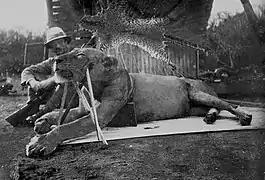Maneless lion
The term "maneless lion" or "scanty mane lion" often refers to a male lion without a mane, or with a weak one.[1][2]

The purpose of the mane is thought to signal the fitness of males to females. Experts disagree as to whether or not the mane defends the male lion's throat in confrontations.[3][4][5][6]
Although lions are known for their mane, not all males have one.[2] This might be because of a polymorphism within males.[7]
Modern lions
In Eurasia
The Asiatic lion is often considered to have a weak mane compared to its cousins in Africa, due to the hot climate in Asia,[9] but this does not always apply. The manes of most lions in ancient Greece and Asia Minor were also less developed and did not extend to below the belly, sides or ulnas. Lions that occurred in Mesopotamia had hair on the underbelly, unlike modern lions in the wilderness of India,[10] and also, a relief from Nineveh in the Mesopotamian Plain shows a lion with underbelly hair. Lions with such smaller manes were also known in the Syrian region, Arabian peninsula and Egypt,[11] while in Gir Forest of India, cases of maneless lions are rarely reported.
In Iran there are often pictures of stone reliefs with Asiatic lions without a mane.
Lions with such smaller manes were also known in the Syrian region and Arabian peninsula.[12][13]
In Africa
In sub-Saharan Africa, lions with weak manes were reported in Murchison Falls National Park, Uganda.
Tsavo is a region of Kenya located at the crossing of the Uganda Railway over the Tsavo River, close to where it meets the Athi-Galana-Sabaki River. Tsavo male lions generally do not have a mane, though colouration and thickness vary. There are several hypotheses as to the reasons. One is that mane development is closely tied to climate because its presence significantly reduces heat loss.[14] An alternative explanation is that manelessness is an adaptation to the thorny vegetation of the Tsavo area in which a mane might hinder hunting. Tsavo males may have heightened levels of testosterone, which could also explain their reputation for aggression.[14]
West African lions are often seen with weak manes or none.[15][16]
Lions in Ancient Egyptian art are usually depicted without a mane, but with a ruff around the neck.[17] The reason for this is not known.[1][18]

 Male East African lion with a scanty mane at Samburu National Reserve, Kenya
Male East African lion with a scanty mane at Samburu National Reserve, Kenya West African lion in Pendjari National Park, Benin
West African lion in Pendjari National Park, Benin
Prehistoric lions
.jpg.webp)
Cave paintings from the Pleistocene epoch often depict lions without manes, even if with the scrotum.[18][20][21]
References
- Joubert, D. (1996). "Letters: By any other mane". New Scientist: 8. Retrieved 22 January 2018.
- "What is a maneless lion?". "Dictionary" by Farlex.
{{cite journal}}: Cite journal requires|journal=(help) - Sankhala, K. (1978). Tiger: The Story of the Indian Tiger. Glasgow, the U.K.: Collins. ISBN 978-0-0021-6124-4.
- Joubert, D. (18 May 1996), Letters: By any other mane", New Scientist
- Peyton, P. M.; Packer, C (2002). "Sexual selection, temperature, and the lion's mane". Science. 297 (5585): 1339–1343. Bibcode:2002Sci...297.1339W. doi:10.1126/science.1073257. PMID 12193785. S2CID 15893512.
- Packer, C. (2023). The Lion: Behavior, Ecology, and Conservation of an Iconic Species. Princeton University Press. pp. 137, 145. ISBN 978-0-691-21529-7.
- Nobuyuki Yamaguchi; Alan Cooper; Lars Werdelin; David W. Macdonald (2004). "Evolution of the mane and group-living in the lion" (PDF). 263 (4). Zoological Society of London: 329–342. doi:10.1017/S0952836904005242.
{{cite journal}}: Cite journal requires|journal=(help) - Sevruguin, A. (1880). "Men with live lion". National Museum of Ethnology in Leiden, The Netherlands; Stephen Arpee Collection. Archived from the original on 26 March 2018. Retrieved 26 March 2018.
- Pocock, R. I. (1939). "Panthera leo". The Fauna of British India, including Ceylon and Burma. Mammalia. – Volume 1. London: Taylor and Francis Ltd. pp. 212–222.
- Ashrafian, Hutan (2011). "An Extinct Mesopotamian Lion Subspecies". Veterinary Heritage. 34 (2): 47–49.
- Heptner, V. G.; Sludskii, A. A. (1992) [1972]. "Lion". Mlekopitajuščie Sovetskogo Soiuza. Moskva: Vysšaia Škola [Mammals of the Soviet Union, Volume II, Part 2]. Washington DC: Smithsonian Institution and the National Science Foundation. pp. 83–95. ISBN 978-90-04-08876-4.
- Heptner, V. G.; Sludskii, A. A. (1992) [1972]. "Lion". Mlekopitajuščie Sovetskogo Soiuza. Moskva: Vysšaia Škola [Mammals of the Soviet Union, Volume II, Part 2]. Washington DC: Smithsonian Institution and the National Science Foundation. pp. 83–95. ISBN 978-90-04-08876-4.
- Barnett, R.; Yamaguchi, N.; Barnes, I. & Cooper, A. (2006). "Lost populations and preserving genetic diversity in the lion Panthera leo: Implications for its ex situ conservation". Conservation Genetics. 7 (4): 507–514. doi:10.1007/s10592-005-9062-0. S2CID 24190889.
- Call the Hair Club for Lions. The Field Museum.
- Schoe, M.; Sogbohossou, E. A.; Kaandorp, J.; De Iongh, H. (2010), "Progress Report – collaring operation Pendjari Lion Project, Benin", The Dutch Zoo Conservation Fund (for funding the project)
- Trivedi, Bijal P. (2005). "Are Maneless Tsavo Lions Prone to Male Pattern Baldness?". The National Geographic. Retrieved 7 July 2007.
- Nagel, D.; Hilsberg, S.; Benesch, A.; Scholtz, J. (2003). "Functional morphology and fur patterns in recent and fossil Panthera species". Scripta Geologica 126: 227–239.
- "Lions of Ancient Egypt". The American University in Cairo Press.
- Chauvet, J.-M.; Brunel, D. E.; Hillaire, C. (1996). Dawn of Art: The Chauvet Cave. The oldest known paintings in the world. New York: Harry N. Abrams.
- Koenigswald, Wighart von (2002). Lebendige Eiszeit: Klima und Tierwelt im Wandel (in German). Stuttgart: Theiss. ISBN 978-3-8062-1734-6.
- Yamaguchi, Nobuyuki; Cooper, A.; Werdelin, L.; MacDonald, David W. (2004). "Evolution of the mane and group-living in the lion (Panthera leo): a review". Journal of Zoology. 263 (4): 329–342. doi:10.1017/S0952836904005242.
